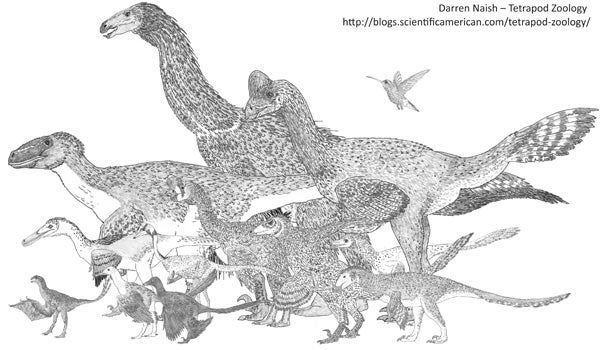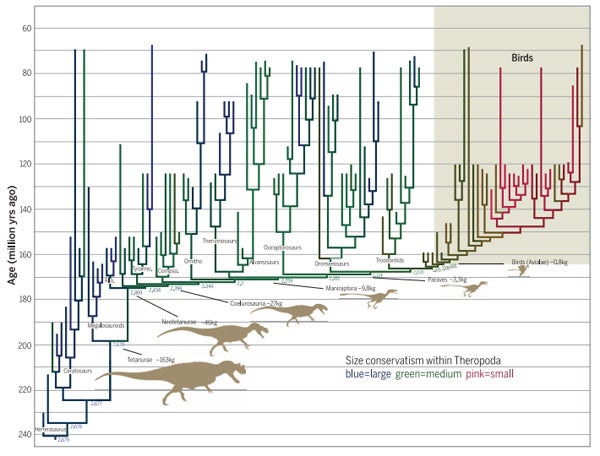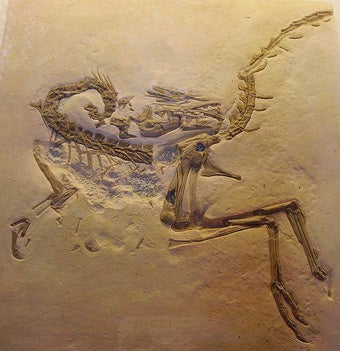This article was published in Scientific American’s former blog network and reflects the views of the author, not necessarily those of Scientific American
One of the dinosaur groups we talk about the most is Maniraptora, the sub-group of theropods (aka ‘predatory dinosaurs’) that includes birds as well as the significantly bird-like dromaeosaurs, troodontids and oviraptors, and the slightly less bird-like therizinosaurs and alvarezsaurs. Excepting birds, all of these groups perished during Cretaceous times.

A maniraptoran montage - including some of the many, many dinosaur illustrations currently showcased at the Tet Zoo patreon project and created for use in my in-prep textbook (for more, click here). Dammit, these illustrations just don't work at small size and low res.
If you’re at all familiar with the world of dinosaur research, you’ll know that an enormous number of new fossil maniraptoran species have been described within recent years. They’re not all from China. Furthermore, a large number of studies have appeared in which authors have discussed the probable behaviour, ecology and lifestyle of given non-bird maniraptoran groups, and have discerned and identified a large number of evolutionary trends and tendencies within the group. There are hypotheses that posit shifts in diet, ecology and evolutionary tempo (Garner et al. 1999, Zanno & Makovicky 2011, Benson et al. 2014, Brusatte et al. 2014), those that identify long-term trends in body size (Lee et al. 2014), those on changes in limb proportions and tail size and length (Allen et al. 2013), those that examine the evolution of aerial behaviour (Dyke et al. 2013, Foth et al. 2014) and the possibility that it evolved on several occasions, those that posit the apparent loss of aerial behaviour (Paul 1988, 2002, Cau et al. 2015), those linking anatomical changes with nesting behaviour (Hopp & Orsen 2004), those that link the evolution and distribution of complex feathers and bony crests with sexual selection (Hone et al. 2011), and so on.
On supporting science journalism
If you're enjoying this article, consider supporting our award-winning journalism by subscribing. By purchasing a subscription you are helping to ensure the future of impactful stories about the discoveries and ideas shaping our world today.

Maniraptorans include the smallest of theropods, but they represent the 'end members' of a long and continuous trend in size reduction among theropods as a whole. This chart, depicting size reduction over the course of theropod history, is from Lee et al. (2014).
In fact, there have been so many studies on the evolutionary trends and tendencies within this group that it might seem that virtually every study proposes an alternative view of the group’s evolutionary history: that numerous different driving events or behavioural scenarios have been put forward as alternative, competing models of maniraptoran evolution.

The most familiar non-bird maniraptorans were jackal- and wolf-sized predators like Deinonychus, shown at left with an unfortunate ornithischian (image by Emily Willoughby, CC BY-SA 3.0). An elongate, tridactyl hand with recurved claws is typical for the group: the image at right shows a Deinonychus hand, the thumb being at the bottom (image by James St. John, CC BY 2.0).
What I want to show in this series of articles is that this isn’t true at all, and that – while things do indeed seem to have been complex – they’re no more complex than they are for any other group of animals, nor is there any major insurmountable conflict as goes the scenarios or driving events that have been proposed, nor are the different evolutionary trends that have been proposed at all in conflict when it comes to the overall pattern that we can discern. Let’s begin…
Maniraptoran origins and affinities. Let’s say to begin with that maniraptorans are deeply nested within coelurosaurian theropods, and there’s compelling character support putting them close to the other coelurosaurian groups: those being tyrannosauroids, Ornitholestes, compsognathids and ornithomimosaurs (ostrich dinosaurs). The clade Maniraptora has been defined in several different ways, but is generally understood (following Gauthier 1986) to be a branch-based clade that includes all those dinosaurs closer to modern birds than to Ornithomimus (see the comments for more on this issue).

Compsognathids - this is the famous Compsognathus longipes specimen from Solnhofen - were evidently close to maniraptoran ancestry. Compsognathids were mostly small (less than 1.5 m long), long-tailed, speedy generalists, though some reached a respectable size (2.5 m or so). Image by Balista, CC BY-SA 3.0.
While, by definition, ostrich dinosaurs have to be the closest relatives of maniraptorans, studies have occasionally found some of those other coelurosaurian groups to be closer to birds than to ostrich dinosaurs, and thus to be maniraptorans too. Those details aren’t too important here: the important point is that maniraptorans emerged from among small or mid-sized (ancestral size = 1-2 m, 10-20 kg; Lee et al. 2014), coelurosaurs with a filamentous integument, no convincing indication of complex, pennaceous feathers, and with a dentition, skull and limb anatomy suggestive of a lifestyle that involved the eating of small animals.

Maniraptorans evolved from coelurosaurs similar to Ornitholestes here (though Ornitholestes itself is too young, geologically, to be anything like the actual ancestor). Photo by Venture Vancouver, CC BY-SA 2.0.
Ok, part II coming soon.
For previous Tet Zoo articles on Mesozoic maniraptorans and related dinosaur groups, see…
Luis Chiappe’s Glorified Dinosaurs: The Origin and Early Evolution of Birds
Did Velociraptor and Archaeopteryx climb trees? Claws and climbing in birds and other dinosaurs
Yi qi Is Neat But Might Not Have Been the Black Screaming Dino-Dragon of Death
Refs - -
Allen, V., Bates, K. T., Li, Z. & Hutchinson, J. R. 2013. Linking the evolution of body shape and locomotor biomechanics in bird-line archosaurs. Nature 497, 104-107.
Brusatte, S. L., Lloyd, G. T., Wang, S. C. & Norell, M. A. 2014. Gradual assembly of avian body plan culminated in rapid rates of evolution across the dinosaur-bird transition. Current Biology 24, 2386-2392.
Foth, C., Tischlinger, H. & Rauhut, O. W. M. 2014. New specimen of Archaeopteryx provides insights into the evolution of pennaceous feathers. Nature 511, 79-82.
Gauthier, J. 1986. Saurischian monophyly and the origin of birds. Memoirs of the California Academy of Science 8, 1-55.
Garner, J. P., Taylor, G. K. & Thomas, A. L. R. 1999. On the origins of birds: the sequence of character acquisition in the evolution of avian flight. Proceedings of the Royal Society of London B 266, 1259-1266.
Hopp, T. P. & Orsen, M. J. 2004. Dinosaur brooding behavior and the origin of flight feathers. In Currie, P. J., Koppelhus, E. B., Shugar, M. A. & Wright, J. L. (eds) Feathered Dragons. Studies on the Transition from Dinosaurs to Birds. Indiana University Press (Bloomington & Indianapolis), pp. 234-250.
Paul, G. S. 1988. Predatory Dinosaurs of the World. Simon & Schuster, New York.
Zanno, L. E. & Makovicky, P. J. 2011. Herbivorous ecomorphology and specialization patterns in theropod dinosaur evolution. Proceedings of the National Academy of Sciences 108, 232-237.